1936 Cord 810 Westchester
There’s a small handful of Cords in Britain but, with the notable exception of Andy Saunders’ recent custom project, you’ve probably never seen one outside a museum. Trevor Cowell is going to remedy that, because he’s just overhauled one and fully intends to use it, as Zack Stiling found out…
Cordial Motoring
Trevor Cowell is no stranger to magazine readers. His impressive stable contains Chevys, Pontiacs, a Ford, a Cadillac and a Mercury. He likes his cars unique, so most are customised to some degree and have been featured in these pages and in other titles. The bar is set high for any Cowell car, but with his latest acquisition he has really outdone himself. The Cord is instantly recognisable even to people who have never seen one. Conceived for society’s elite, its celebrity has endured on account of it being one of the most original and striking examples of pre-war car design. In appearance, it is neither American nor European. With its concealed lights and distinctive ‘coffin nose’, it scarcely resembles a product of the Thirties. A Cord is a Cord and that’s that.
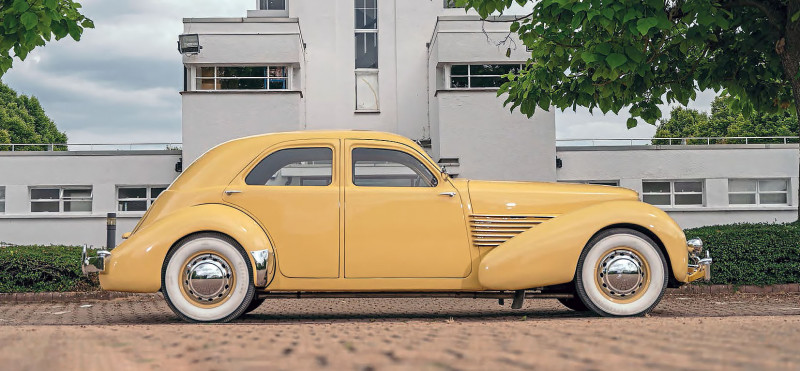
“THE CORD WAS THE USA’S FIRST FRONT WHEEL DRIVE CAR. IT WAS A REAL STROKE OF GENIUS.”
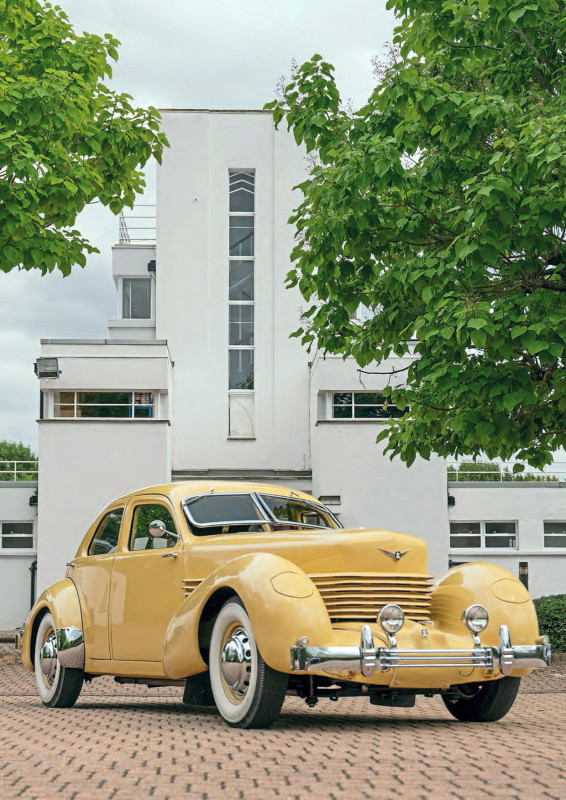
It’s even admired by people who don’t ordinarily care for American cars. As Ian Fleming wrote in Live and Let Die: “Leiter had got hold of an old Cord, one of the few American cars with a personality, and it cheered Bond to climb into the low-hung saloon, to hear the solid bite of the gears and the masculine tone of the wide exhaust. Fifteen years old, he reflected, yet still one of the most modern-looking cars in the world.”
“FOR A CAR THAT’S 87 YEARS OLD, IT DRIVES QUITE WELL. I WOULD IMAGINE MOST PRE-WAR CARS ARE MORE HORRIFIC! I MIGHT RELENT AND PUT A SET OF RADIAL TYRES ON...”
In his own words, its 30-year-old stylist Gordon Buehrig designed it “to look right”. He had been briefed with designing a ‘baby Duesenberg’; Auburn, Cord and Duesenberg all being marques owned by Errett Lobban Cord and built in Indiana. The 810 (renamed 812 for 1937) famously used front-wheel drive, reviving the technology used in the very first Cord of 1929. Production at the Connersville factory began in 1936, but only 2995 810/812s were made before allegations of financial fraud forced E L Cord to sell his motor-manufacturing empire.

The 1929 Cord was America’s first front-wheel drive production car, but let’s consider the innovations of the 810. How many other cars from 1936 were low enough to dispense with running boards, or fitted with fully covered steel wheels, the covers vented for brake cooling? There is no visible radiator, no roof gutter, and the door hinges are concealed. The mechanical pop-up lights are cranked open from the dash. Inside, the steering wheel horn ring was a first, and edge lighting for the instruments and the integrated radio were outrageously futuristic. Irrespective of the Cord’s desirability, Trevor hadn’t actively sought one. “Does anyone ever look for a Cord?” he asks. He just saw this 1936 810 Westchester sedan for sale on Car & Classic and was quite taken. After a while, it hadn’t sold and the price fell, so he made his move.

It was owned by a pre-war car enthusiast in Dorset who imported it from Sweden in 2016 especially for a wedding, and it hadn’t been used since. Trevor went to drive it home on Boxing Day 2020, which should have been the perfect Christmas present, but for two things. “First,” recalls Trevor, “one of the rear brakes got stuck on at the petrol station just up from the guy’s house, so we had to bash that about to free it. Then, 10 miles on, it started to lose power. We were driving at 20mph with a massive queue of cars behind us, so we pulled into a pub car park and realised we weren’t going any further.”
After a lift home from the AA, he went for a drive the next day and, again, the Cord was fine for about 10 miles until it started misfiring. “It turned out to be the coil,” he says. “It had already been converted to PerTronix electronic ignition (www.pertronixeurope.com), but it had the original Cord coil which just wasn’t up to it. As soon as it got warm it failed.”
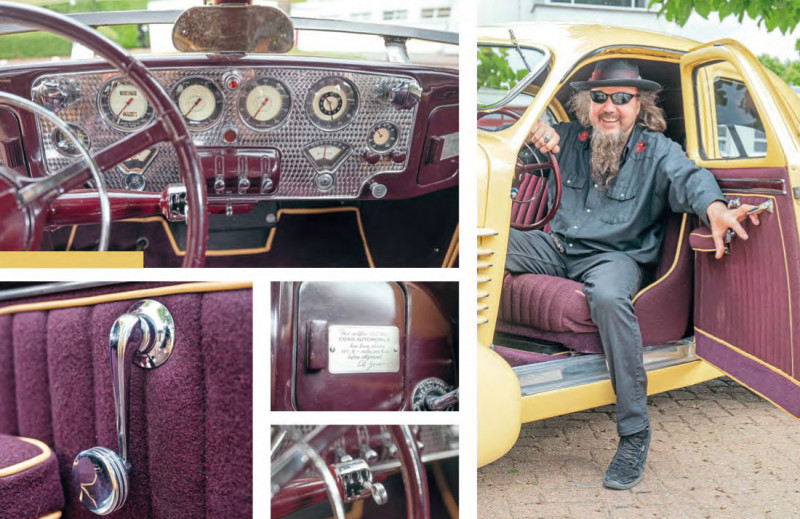
A new coil was first on the long list of jobs Trevor undertook. He greased the CV joints, rebuilt the wheel cylinders and the brake master cylinder, had the shoes relined and had new flexible front brake lines made. The front leverarm dampers were rebuilt, while the rear dampers were converted to telescopics. Half the electrics had questionable wiring, so he redid that and got everything working properly. With the Cord being markedly different from Trevor’s post-war cars, he says: “I had to find out how to do all that, and make special tools. It’s lowered two inches at the back as Cords always stick up too high.”
The mechanical work didn’t take long. It was finished by April 2021, with much of the time consumed by jobs like having the brake lines made because you can’t buy spares for a Cord like you can for a Chevrolet. Cosmetically, the paint had to be dry-sanded back then mopped and polished to revive it, but it was the interior which would be time-consuming.
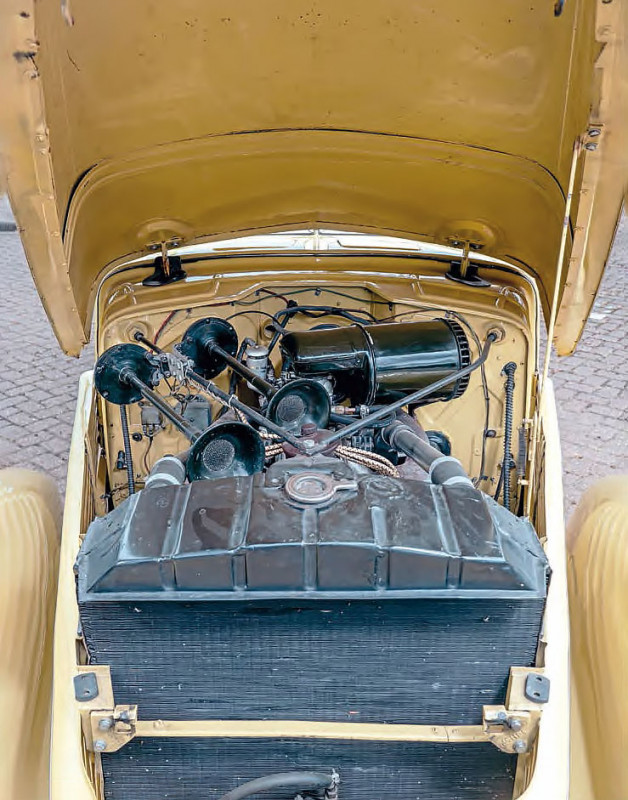
125bhp 289cu in flathead V8
The seat covers and carpets were getting threadbare, so Trevor sent the Cord to Joe Gillard of Unique Auto Trimming (Tel. 01372 450076). Although not much of its history is known, a little came to light when the interior was removed. “When we took the material off the seat, underneath it had ‘Larry Sneed Interiors 1979’ written on it. Sneed made his career out of doing hot-rod interiors, and the Cord was his second ever job. He was amazed that it was still as he’d done it.”
Having made contact with Sneed, he confirmed what Trevor suspected: that the Cord had originally been burgundy. It must have been in the Kentucky area in the Seventies and Eighties as that was Sneed’s domain, but it went to Sweden in the Nineties, where it was painted. The colour is Cigarette Cream, which sounds like a particularly unpleasant type of biscuit but is, in fact, an original Cord hue, albeit one which was only used for 1937. The less said about the racing stripes which were applied, the better… The engine was rebuilt in Sweden, with all the work being finished around 2010, after which it saw gentle use going to shows.
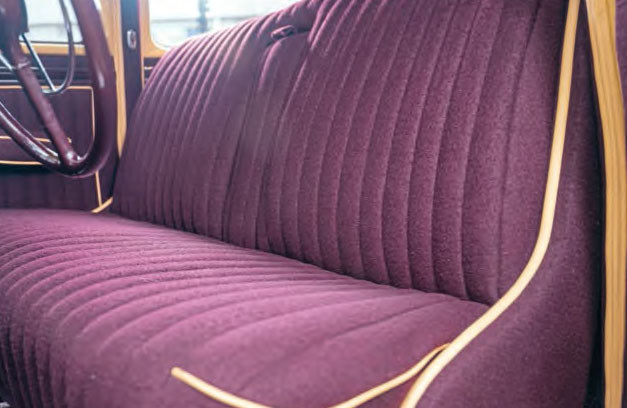
Trevor has retained the brilliantly Seventies plum upholstery, but with some improvements. “The interior was plain broadcloth,” he explains, “but we added the tuck ‘n’ roll and piping because a lot were originally done in that style, and we thought it would give it more pizzazz.” So many pre-war cars are spoilt by glaringly obvious modern indicators, but he has fitted Lucas-style chrome LED indicators which not only blend in seamlessly, but enhance the Cord’s aura of streamlined Art Deco glamour.
Apart from these minor deviations from standard, Trevor’s is a very correct example with its original engine. The 810 was launched with an all-new 289cu in/ 4727cc flathead V8 which developed 125bhp at 3200rpm, and the 812 was offered with an optional supercharger, identifiable by the unmissable chrome exhaust pipes which burst forth from the bonnet and then vanish into the wings.
As Cord spares dried up in the Sixties and Seventies, many were fitted with convenient replacements, the 350 Chevy being particularly common. Trevor has even come across one with a Citroën Light 15 motor. One winces to think how leisurely its pace must be…
Happily, this Cord has its original flathead and four-speed synchromesh transaxle, which can be used as a kind of pre-selector, with the gear-change controlled by a complicated Bendix system using the engine vacuum and solenoid valves. With the interior finished in October 2021, the Cord went to some local shows before having its first long-distance run to the 2022 Rally of the Giants, where it won Classic American’s Car of the Year heat. So it impressed us, not to mention countless other rally-goers, but what does Trevor make of it himself?
“The steering is quite heavy. Being front-wheel drive, it wants to pull itself in a straight line, so it does understeer. The cross-ply tyres are the worst thing; on a motorway, it will suddenly have a mind of its own. The brakes are quite hard as there’s no servo. They’re okay, but not brilliant. You still always wonder whether the gear-shift is going to work… The engine pulls quite well; it bumbles along nicely. It’s smooth and quiet and doesn’t lack power. It runs like a little sewing machine.”
Despite his honest criticisms, he concludes: “For a car that’s 87 years old, it drives quite well. I would imagine most pre-war cars are more horrific! I might relent and put radials on it as long as they look like cross-plies. They’re the one thing that spoils driving. If you could relax a bit more at 60mph, it wouldn’t be so bad.”
That’s all very well from a 21st-century perspective, but in 1936 the universal reaction was “What a car!” Nothing matches it for styling, and one wonders if there was ever so much innovation and genius contained in a single production car. Driving it may be a little laborious by modern standards, but if you ever tire of it, you can just drive it into your living room and call it modern art.
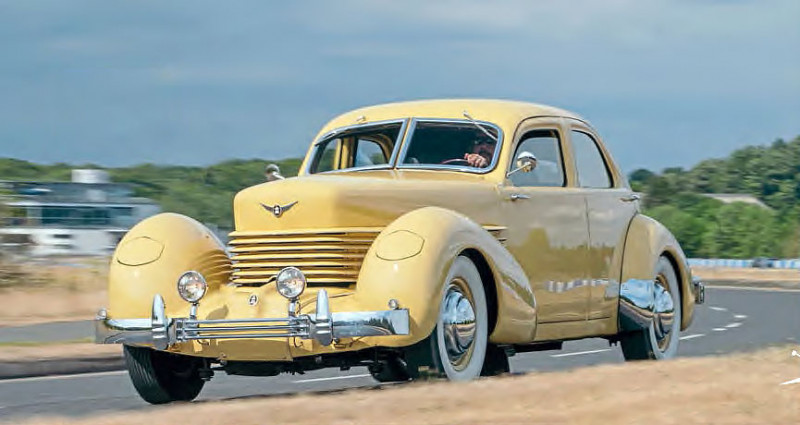
One cowl flap is for ventilation, the other is where the fuel filler resides!
Manual hide-away headlamps. Hence ‘coffin-nosed’.
There’s even a plaque in the Cord to certify it had been driven at 110mph before shipment.
Rear styling is almost fastback
These Cords must have looked so futuristic in the mid- Thirties and even today present a handsome futuristic profile.
Chrome trimmed hood louvres. Original factory front spots.
Magnificent turned dash. Fine detail. Electric gear selector. Owner Trevor Cowell. Interior was reupholstered in smart plum colour, with tan piping.
Art Deco building in Brooklands makes the perfect backdrop.
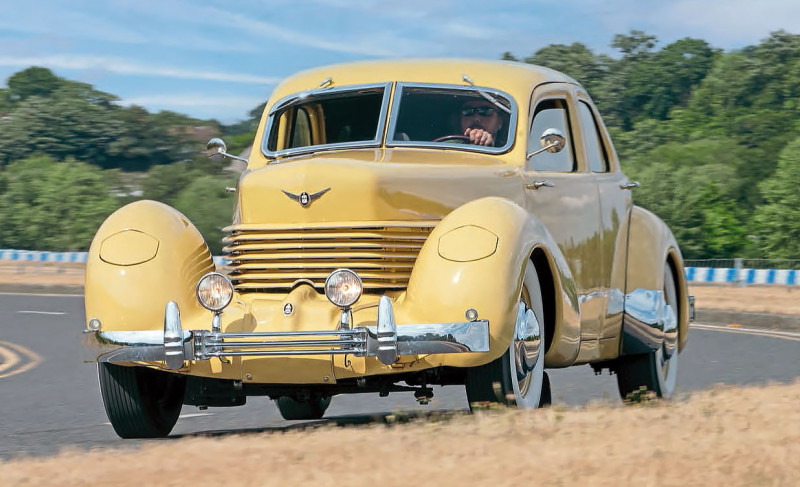


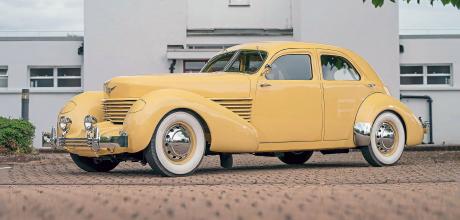
Unless you have a bottomless pit of money to throw at your car, it appears to be you don’t have a chance to even qualify. This to me does not give the person with his pride and joy, keeping it on the road with a limited budget, any chance of being recognised. This also brings up another issue to me. The magazine puts nice cars in, but I feel the budget-restricted owners are being left out. It would be nice if you did features on what I class as normal people with normal cars. By this I mean cars as they came from the factory and kept that way. Not expensively restored and modified. There must be a lot of American car owners that agree with me. The various local meets I go to certainly have a vast array of this type of car, but we don’t appear to see them in your site.
Well, Graham, as was pointed out last month, Car of the Year last year was run no differently from any of the previous 30-odd years. It’s a concours competition, always has been and is judged on points awarded to each individual car, awarded by three separate independent judges that are all tallied up at the end on Sunday afternoon prior to the announcement of the winner. If any car in any condition was eligible to enter, what criteria would one use to choose such cars? How would they be judged, or would it just be a case of spinning a roulette wheel? As for having two categories for restored and original, only one of the cars last year could possibly have qualified for the ‘original’ category, which means it would have won that category simply on merit of having been the only car within that class! As for featuring ordinary or ‘normal’ cars that’s something we regularly do. Out of the four cars featured last month (April) three would easily fit into that category: the 1979 Trans Am, low mileage, all original and unmodified, the 1954 Chevrolet Bel Air, again a nice clean, straight car, unmodified and the 1970 Lincoln Continental, again low mileage, good straight condition and not hideously expensive to buy… We could fill the magazine with cheap ’n’ cheerful Chrysler 300s or V6 Camaros all day long, but when presented with the opportunity of featuring something as unique and rare as a 1936 Cord, it would seem a no-brainer to feature the latter!